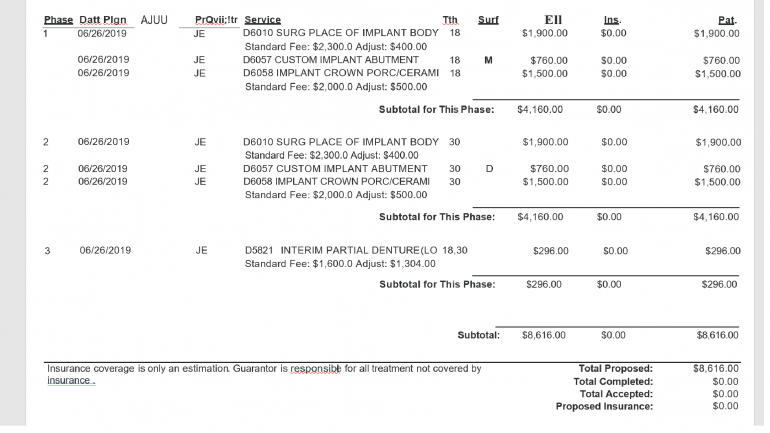
Dental Code D5958: Palatal Lift Prosthesis, Interim
Dental Code D5958 is a specific code used in dentistry to identify and bill for a dental procedure known as the palatal lift prosthesis. This procedure involves the creation and placement of an interim palatal lift prosthesis, which is a removable dental appliance designed to assist patients with speech and swallowing difficulties caused by conditions such as palatal weakness or paralysis.
Detailed Information about the Procedure
Dental Code D5958 refers to the creation and placement of an interim palatal lift prosthesis. This removable dental appliance is designed to aid patients with speech and swallowing difficulties caused by palatal weakness or paralysis. The procedure involves an initial assessment, impressions, prosthesis fabrication, fitting, and adjustments. Regular follow-up visits are necessary to monitor the prosthesis's performance. It is important to consult with a dental professional for a proper evaluation and personalized treatment plan.
Initial Assessment and Diagnosis
The first and crucial step in the process of creating and placing a palatal lift prosthesis is the initial assessment and diagnosis performed by a qualified dental professional. During this assessment, the dentist carefully examines the patient's oral cavity, focusing on the roof of the mouth (palate). The purpose of this examination is to determine the extent of the palatal weakness or paralysis and assess the patient's suitability for a palatal lift prosthesis.
The dentist may employ various diagnostic tools such as visual examination, palpation, and imaging scans like X-rays. These tools aid in evaluating the condition of the palate, identifying any underlying structural abnormalities, and determining the appropriate treatment approach.
Impressions and Bite Registration
Once the diagnosis is confirmed, the dentist proceeds with taking impressions of the patient's oral structures. Impressions are created using a putty-like material that captures the shape and contours of the palate, teeth, and surrounding tissues. These impressions serve as a foundation for creating a custom-fitted palatal lift prosthesis that precisely matches the patient's mouth.
In addition to impressions, a bite registration is also taken during this step. A bite registration records the relationship between the upper and lower jaws, ensuring that the palatal lift prosthesis fits harmoniously with the patient's bite and does not disrupt the occlusion.
Prosthesis Fabrication
After obtaining the impressions and bite registration, a skilled dental laboratory technician takes charge of fabricating the palatal lift prosthesis. The technician uses the impressions to create a stone model that replicates the patient's oral structures. This model serves as a guide for constructing the prosthesis and ensures a customized fit.
The fabrication process involves the careful sculpting and shaping of the prosthesis to accurately match the contours of the patient's palate. It may also involve incorporating metal components, such as clasps or wires, into the prosthesis to enhance stability and retention. The materials used for the prosthesis are typically acrylic resin or other biocompatible materials that are safe and durable for intraoral use.
Fitting and Adjustments
Once the palatal lift prosthesis is fabricated and ready, the patient returns to the dental office for a fitting appointment. During this appointment, the dentist evaluates the fit and comfort of the prosthesis. The prosthesis is inserted into the patient's mouth, and the dentist assesses its positioning, stability, and overall functionality.
If any adjustments are necessary, the dentist makes the required modifications to ensure proper alignment and comfort. These adjustments ensure that the prosthesis effectively lifts the palate, aiding in speech and swallowing functions. The dentist also provides detailed instructions to the patient on how to correctly insert and remove the prosthesis, as well as how to maintain proper oral hygiene.
Follow-up and Ongoing Care
After the fitting and adjustment process, the patient will typically have follow-up appointments with the dentist. These appointments serve to monitor the performance of the palatal lift prosthesis and address any concerns or issues that may arise. The dentist evaluates the patient's progress, checks the fit of the prosthesis, and makes any necessary modifications to optimize its effectiveness.
The patient is encouraged to communicate any difficulties or discomfort experienced while wearing the prosthesis during these follow-up visits. Regular dental visits are essential to ensure the ongoing success of the palatal lift prosthesis and to address any emerging oral health concerns that may affect its functionality.
Summary of Dental Code D5958
Dental Code D5958 represents the palatal lift prosthesis, an interim dental appliance designed to address speech and swallowing difficulties resulting from palatal weakness or paralysis. The procedure involves an initial assessment and diagnosis to determine the patient's suitability for the prosthesis. Impressions and bite registration are taken to create a custom-fitted prosthesis, which is fabricated by a dental laboratory technician. The prosthesis is then fitted, adjusted, and monitored through follow-up appointments to ensure its optimal performance.
It is important to note that the palatal lift prosthesis is an interim solution and not a permanent fix. Its purpose is to assist patients in enhancing their speech and swallowing functions while underlying causes are addressed.
Explore a world of affordable smiles with
Dr. BestPrice! Your dental wellness journey starts here.